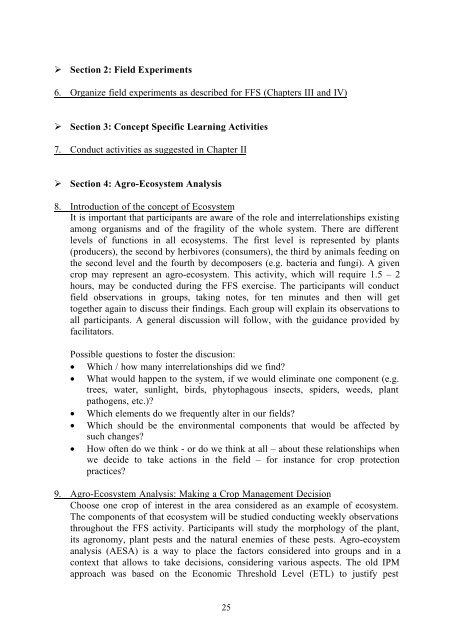Manual for Training of Extension Workers and Farmers on ... - DTIE
Manual for Training of Extension Workers and Farmers on ... - DTIE
Manual for Training of Extension Workers and Farmers on ... - DTIE
Create successful ePaper yourself
Turn your PDF publications into a flip-book with our unique Google optimized e-Paper software.
‣ Secti<strong>on</strong> 2: Field Experiments<br />
6. Organize field experiments as described <str<strong>on</strong>g>for</str<strong>on</strong>g> FFS (Chapters III <str<strong>on</strong>g>and</str<strong>on</strong>g> IV)<br />
‣ Secti<strong>on</strong> 3: C<strong>on</strong>cept Specific Learning Activities<br />
7. C<strong>on</strong>duct activities as suggested in Chapter II<br />
‣ Secti<strong>on</strong> 4: Agro-Ecosystem Analysis<br />
8. Introducti<strong>on</strong> <str<strong>on</strong>g>of</str<strong>on</strong>g> the c<strong>on</strong>cept <str<strong>on</strong>g>of</str<strong>on</strong>g> Ecosystem<br />
It is important that participants are aware <str<strong>on</strong>g>of</str<strong>on</strong>g> the role <str<strong>on</strong>g>and</str<strong>on</strong>g> interrelati<strong>on</strong>ships existing<br />
am<strong>on</strong>g organisms <str<strong>on</strong>g>and</str<strong>on</strong>g> <str<strong>on</strong>g>of</str<strong>on</strong>g> the fragility <str<strong>on</strong>g>of</str<strong>on</strong>g> the whole system. There are different<br />
levels <str<strong>on</strong>g>of</str<strong>on</strong>g> functi<strong>on</strong>s in all ecosystems. The first level is represented by plants<br />
(producers), the sec<strong>on</strong>d by herbivores (c<strong>on</strong>sumers), the third by animals feeding <strong>on</strong><br />
the sec<strong>on</strong>d level <str<strong>on</strong>g>and</str<strong>on</strong>g> the fourth by decomposers (e.g. bacteria <str<strong>on</strong>g>and</str<strong>on</strong>g> fungi). A given<br />
crop may represent an agro-ecosystem. This activity, which will require 1.5 – 2<br />
hours, may be c<strong>on</strong>ducted during the FFS exercise. The participants will c<strong>on</strong>duct<br />
field observati<strong>on</strong>s in groups, taking notes, <str<strong>on</strong>g>for</str<strong>on</strong>g> ten minutes <str<strong>on</strong>g>and</str<strong>on</strong>g> then will get<br />
together again to discuss their findings. Each group will explain its observati<strong>on</strong>s to<br />
all participants. A general discussi<strong>on</strong> will follow, with the guidance provided by<br />
facilitators.<br />
Possible questi<strong>on</strong>s to foster the discusi<strong>on</strong>:<br />
• Which / how many interrelati<strong>on</strong>ships did we find?<br />
• What would happen to the system, if we would eliminate <strong>on</strong>e comp<strong>on</strong>ent (e.g.<br />
trees, water, sunlight, birds, phytophagous insects, spiders, weeds, plant<br />
pathogens, etc.)?<br />
• Which elements do we frequently alter in our fields?<br />
• Which should be the envir<strong>on</strong>mental comp<strong>on</strong>ents that would be affected by<br />
such changes?<br />
• How <str<strong>on</strong>g>of</str<strong>on</strong>g>ten do we think - or do we think at all – about these relati<strong>on</strong>ships when<br />
we decide to take acti<strong>on</strong>s in the field – <str<strong>on</strong>g>for</str<strong>on</strong>g> instance <str<strong>on</strong>g>for</str<strong>on</strong>g> crop protecti<strong>on</strong><br />
practices?<br />
9. Agro-Ecosystem Analysis: Making a Crop Management Decisi<strong>on</strong><br />
Choose <strong>on</strong>e crop <str<strong>on</strong>g>of</str<strong>on</strong>g> interest in the area c<strong>on</strong>sidered as an example <str<strong>on</strong>g>of</str<strong>on</strong>g> ecosystem.<br />
The comp<strong>on</strong>ents <str<strong>on</strong>g>of</str<strong>on</strong>g> that ecosystem will be studied c<strong>on</strong>ducting weekly observati<strong>on</strong>s<br />
throughout the FFS activity. Participants will study the morphology <str<strong>on</strong>g>of</str<strong>on</strong>g> the plant,<br />
its agr<strong>on</strong>omy, plant pests <str<strong>on</strong>g>and</str<strong>on</strong>g> the natural enemies <str<strong>on</strong>g>of</str<strong>on</strong>g> these pests. Agro-ecoystem<br />
analysis (AESA) is a way to place the factors c<strong>on</strong>sidered into groups <str<strong>on</strong>g>and</str<strong>on</strong>g> in a<br />
c<strong>on</strong>text that allows to take decisi<strong>on</strong>s, c<strong>on</strong>sidering various aspects. The old IPM<br />
approach was based <strong>on</strong> the Ec<strong>on</strong>omic Threshold Level (ETL) to justify pest<br />
25
















